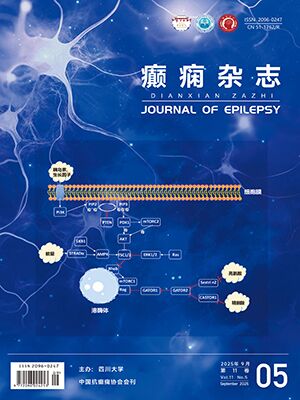| 1. |
Crino PB, Chou K. Epilepsy and cortical dysplasias. Curr Treat Options Neurol, 2000, 2(5):543-552.
|
| 2. |
Laplante M, Sabatini DM. mTOR signaling in growth control and disease. Cell, 2012, 149(11):274-293.
|
| 3. |
Orlova KA, Crino PB. The tuberous sclerosis complex. Ann N Y Acad Sci, 2010, 1184(3):87-105.
|
| 4. |
Lee JH, Huynh M, Silhavy JL, et al. De novo somatic mutations in components of the PI3K-AKT3-mTOR pathway cause hemimegal encephaly. Nat Genet, 2012, 44(10):941-945.
|
| 5. |
Orlova KA, Parker WE, Heuer GG, et al. STRADalpha deficiency results in aberrant mTORC1 signaling during corticogenesis in humans and mice. J Clin Invest, 2010, 120(8):1591-1602.
|
| 6. |
Puffenberger EG, Strauss KA, Ramsey KE, et al. Polyhydramnios, megalencephaly and symptomatic epilepsy caused by a homozygous 7-kilobase deletion in LYK5. Brain, 2007, 130(7):1929-1941.
|
| 7. |
Wong M. Mammalian target of rapamycin (mTOR) pathways in neurological diseases. Biomed J, 2013, 36(2):40-50.
|
| 8. |
Wong M, Crino PB. mTOR and epileptogenesis in developmental brain malformations. In Noebels JL, Avoli M, Rogawski MA, et al. (Eds) Jasper's basic mechanisms of the epilepsies. Bethesda, MD:National Center for Biotechnology Information (US), 2012.
|
| 9. |
Zeng LH, Rensing NR, Wong M. The mammalian target of rapamycin signaling pathway mediates epileptogenesis in a model of temporal lobe epilepsy. J Neuro Sci, 2009, 29(1):6964-6972.
|
| 10. |
Huang X, Zhang H, Yang J, et al. Pharmacological inhibition of the mammalian target of rapamycin pathway suppresses acquired epilepsy. Neurobiol Dis, 2010, 40(2):193-199.
|
| 11. |
Ljungberg MC, Bhattacharjee MB, Lu Y, et al. Activation of mammalian target of rapamycin in cytomegalic neurons of human cortical dysplasia. Ann Neurol, 2006, 60(10):420-429.
|
| 12. |
Aronica E, Boer K, Baybis M, et al. Co-expression of cyclin D1 and phosphorylated ribosomal S6 proteins in hemimegalencephaly. Acta Neuropathol, 2007, 114(4):287-293.
|
| 13. |
Miyata H, Chiang AC, Vinters HV. Insulin signaling pathways in cortical dysplasia and TSC-tubers:tissue microarray analysis. Ann Neurol, 2004, 56(10):510-519.
|
| 14. |
Baybis M, Yu J, Lee A, et al. mTOR cascade activation distinguishes tubers from focal cortical dysplasia. Ann Neurol, 2004, 56(5):478-487.
|
| 15. |
Sha LZ, Xing XL, Zhang D, et al. Mapping the spatio-temporal pattern of the mammalian target of rapamycin (mTOR) activation in temporal lobe epilepsy. PLoS ONE, 2012, 7(1):e39152.
|
| 16. |
Sosunov AA, Wu X, McGovern RA, et al. The mTOR pathway is activated in glial cells in mesial temporal sclerosis. Epilepsia, 2012, 53(Suppl. 1):78-86.
|
| 17. |
Sarbassov DD, Ali SM, Sengupta S, et al. Prolonged rapamycin treatment inhibits mTORC2 assembly and Akt/PKB. Mol Cell, 2006, 22(9):159-168.
|
| 18. |
Backman SA, Stambolic V, Suzuki A, et al. Deletion of Pten in mouse brain causes seizures, ataxia and defects in soma size resembling Lhermitte-Duclos disease. Nat Genet, 2001, 29(7):396-403.
|
| 19. |
Kwon CH, Zhu X, Zhang J, et al. Pten regulates neuronal soma size:a mouse model of Lhermitte-Duclos disease. Nat Genet, 2001, 29(6):404-411.
|
| 20. |
Ljungberg MC, Sunnen CN, Lugo JN, et al. Rapamycin suppresses seizures and neuronal hypertrophy in a mouse model of cortical dysplasia. Dis Model Mech, 2009, 2(5):389-398.
|
| 21. |
Sunnen CN, Brewster AL, Lugo JN, et al. Inhibition of the mammalian target of rapamycin blocks epilepsy progression in NS-Pten conditional knockout mice. Epilepsia, 2011, 52(8):2065-2075.
|
| 22. |
Brewster AL, Lugo JN, Patil VV, et al. Rapamycin reverses status epilepticus-induced memory deficits and dendritic damage. PLoS ONE, 2013, 8(2):e57808.
|
| 23. |
Hoeffer CA, Klann E. mTOR signaling:at the crossroads of plasticity, memory and disease. Trends Neurosci, 2010, 33(4):67-75.
|
| 24. |
Guertin DA, Sabatini DM. Defining the role of mTOR in cancer. Cancer Cell, 2007, 12(10):9-22.
|
| 25. |
Talos DM, Sun H, Zhou X, et al. The interaction between early life epilepsy and autistic-like behavioral consequences:a role for the mammalian target of rapamycin (mTOR) pathway. PLoS ONE, 2012, 7(2):e35885.
|
| 26. |
Dello Russo C, Lisi L, Feinstein DL, et al. mTOR kinase, a key player in the regulation of glial functions:relevance for the therapy of multiple sclerosis. Glia, 2013, 61(7):301-311.
|
| 27. |
Vezzani A, French J, Bartfai T, et al. The role of inflammation in epilepsy. Nat Rev Neurol, 2011, 7(3):31-40.
|
| 28. |
Kettenmann H, Hanisch UK, Noda M, et al. Physiology of microglia. Physiol Rev, 2011, 91(7):461-553.
|
| 29. |
Bajorat R, Wilde M, Sellmann T, et al. Seizure frequency in pilocarpine-treated rats is independent of circadian rhythm. Epilepsia, 2011, 52(12):e118-e122.
|
| 30. |
Goffin K, Nissinen J, Van Laere K, et al. Cyclicity of spontaneous recurrent seizures in pilocarpine model of temporal lobe epilepsy in rat. Exp Neurol, 2007, 205(11):501-505.
|
| 31. |
Williams PA, White AM, Clark S, et al. Development of spontaneous recurrent seizures after kainate-induced status epilepticus. J Neurosci, 2009, 29(7):2103-2112.
|
| 32. |
Kadam SD, White AM, Staley KJ, et al. Continuous electroencephalographic monitoring with radio-telemetry in a rat model of perinatal hypoxia-ischemia reveals progressive post-stroke epilepsy. J Neurosci, 2010, 30(8):404-415.
|
| 33. |
Lasarge CL, Danzer SC. Mechanisms regulating neuronal excitability and seizure development following mTOR pathway hyperactivation. Front Mol Neurosci, 2014, 7(3):18.
|
| 34. |
Buckmaster PS, Ingram EA, Wen X. Inhibition of the mammalian target of rapamycin signaling pathway suppresses dentate granule cell axon sprouting in a rodent model of temporal lobe epilepsy. J Neurosci, 2009, 29(7):8259-8269.
|
| 35. |
Ming GL, Song H. Adult neurogenesis in the mammalian brain:significant answers and significant questions. Neuron, 2011, 70(2):687-702.
|
| 36. |
Pun RY, Rolle IJ, Lasarge CL, et al. Excessive activation of mTOR in postnatally generated granule cells is sufficient to cause epilepsy. Neuron, 2012, 75:1022-1034.
|
| 37. |
Devinsky O, Vezzani A, Najjar S, et al. Glia and epilepsy:excitability and inflammation. Trends Neurosci, 2013, 36(7):174-184.
|
| 38. |
Krueger DA, Wilfong AA, Holland-Bouley K, et al. Everolimus treatment of refractory epilepsy in tuberous sclerosis complex. Ann Neurol, 2013, 74(5):679-687.
|
| 39. |
Zeng LH, Xu L, Gutmann DH, et al. Rapamycin prevents epilepsy in a mouse model of tuberous sclerosis complex. Ann Neurol, 2008, 63(2):444-453.
|
| 40. |
Zhou J, Blundell J, Ogawa S, et al. Pharmacological inhibition of mTORC1 suppresses anatomical, cellular, and behavioral abnormalities in neural-specific Pten knock-out mice. J Neurosci, 2009, 29(2):1773-1783.
|
| 41. |
Hailer NP. Immunosuppression after traumatic or ischemic CNS damage:it is neuroprotective and illuminates the role of microglial cells. Prog Neurobiol, 2008, 84(3):211-233.
|




